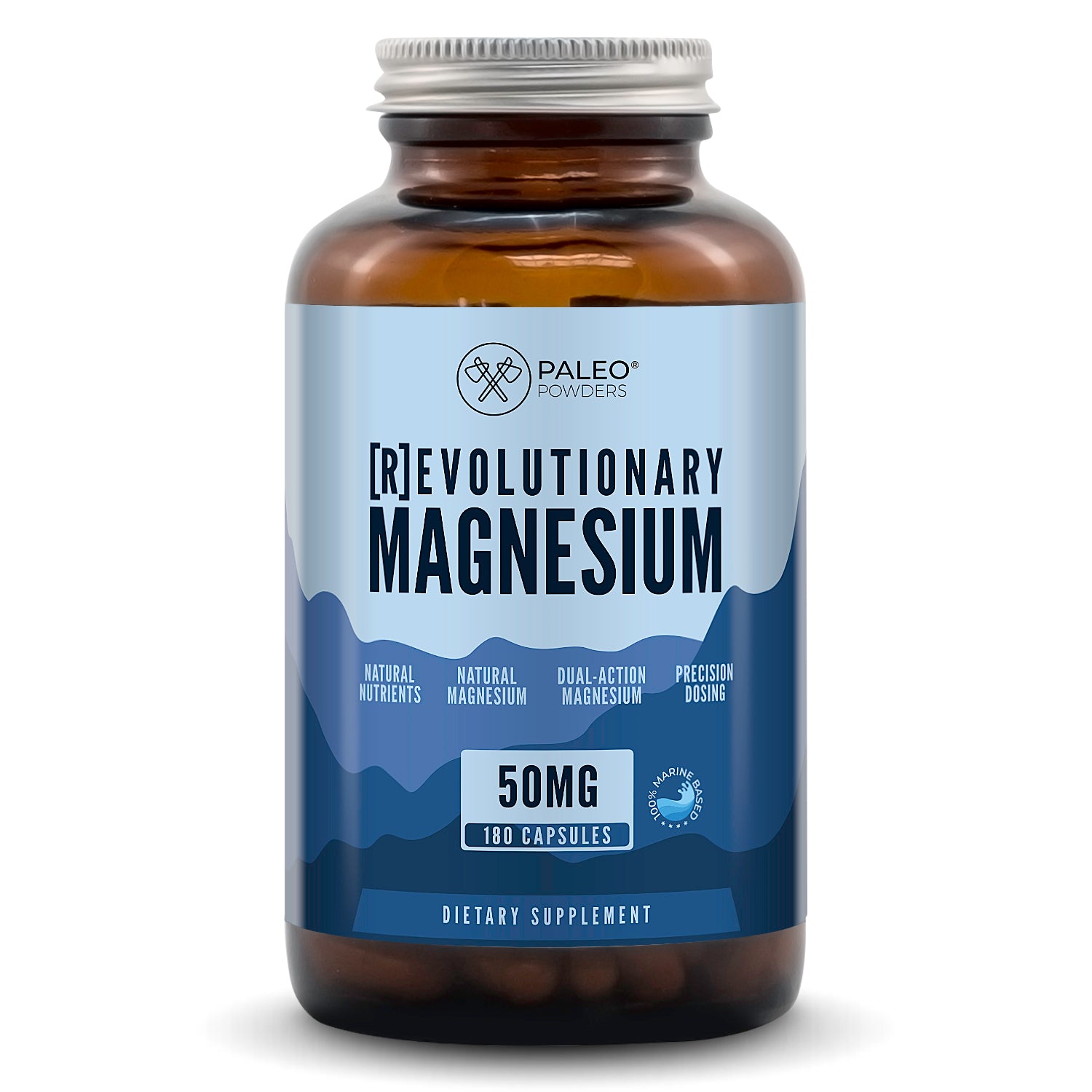
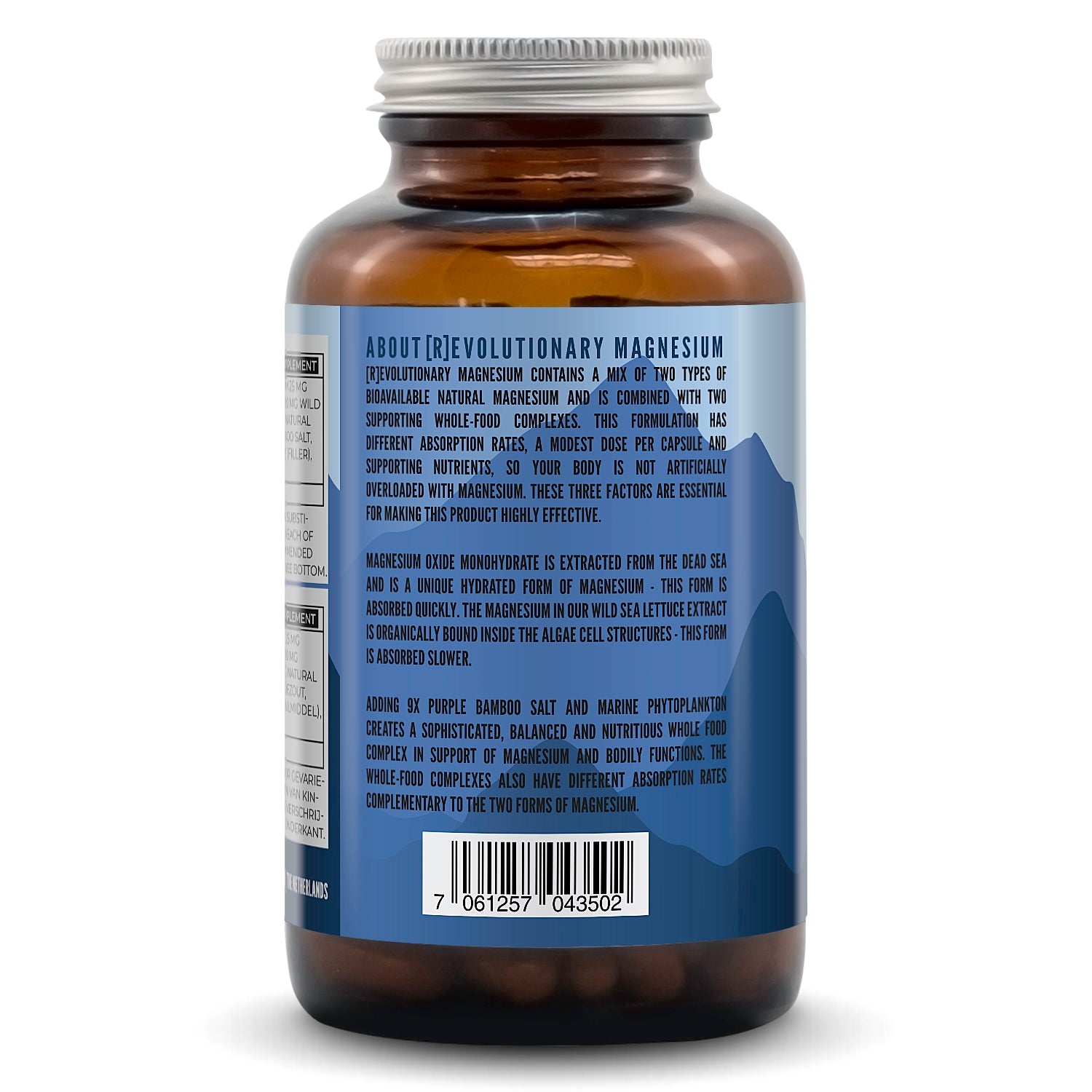
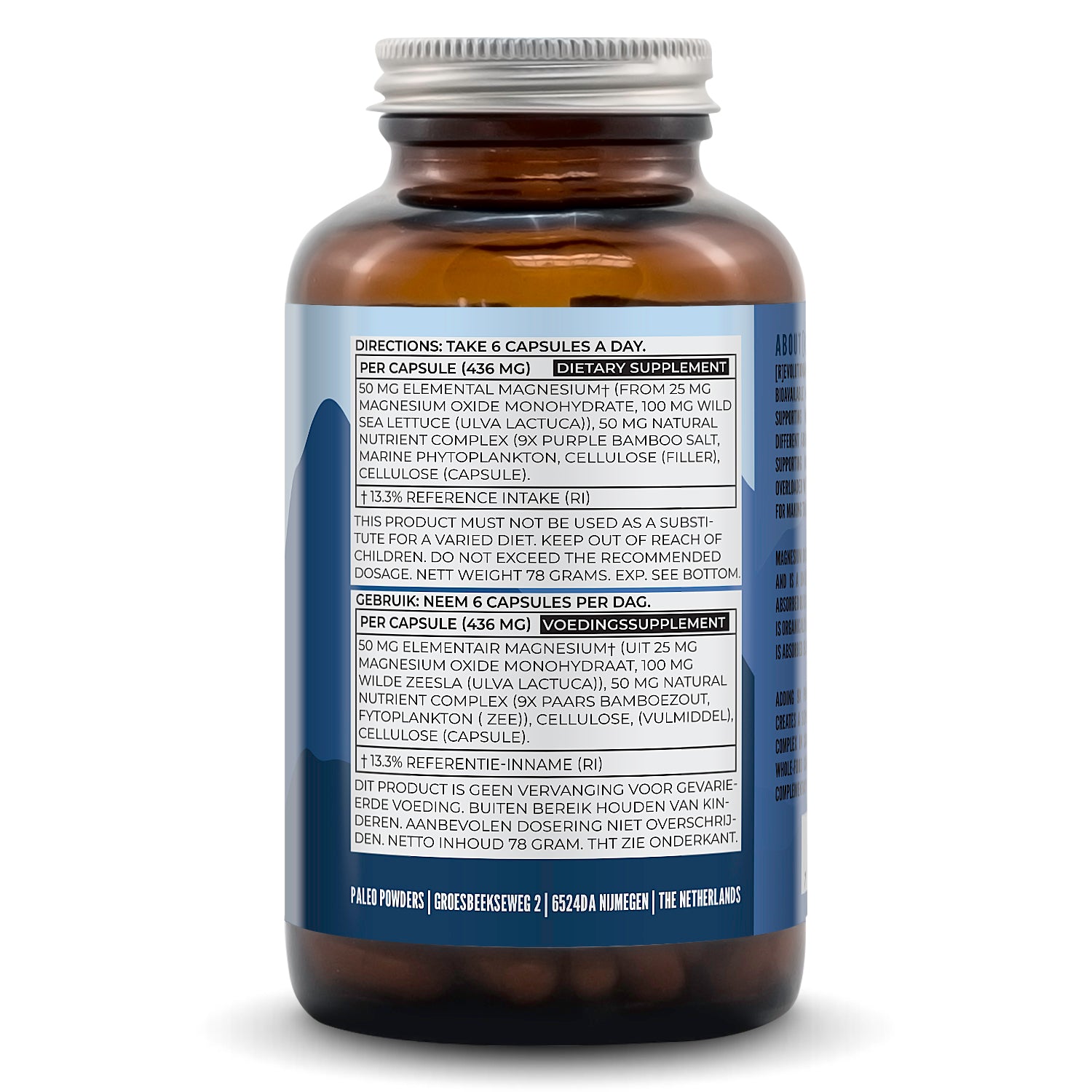
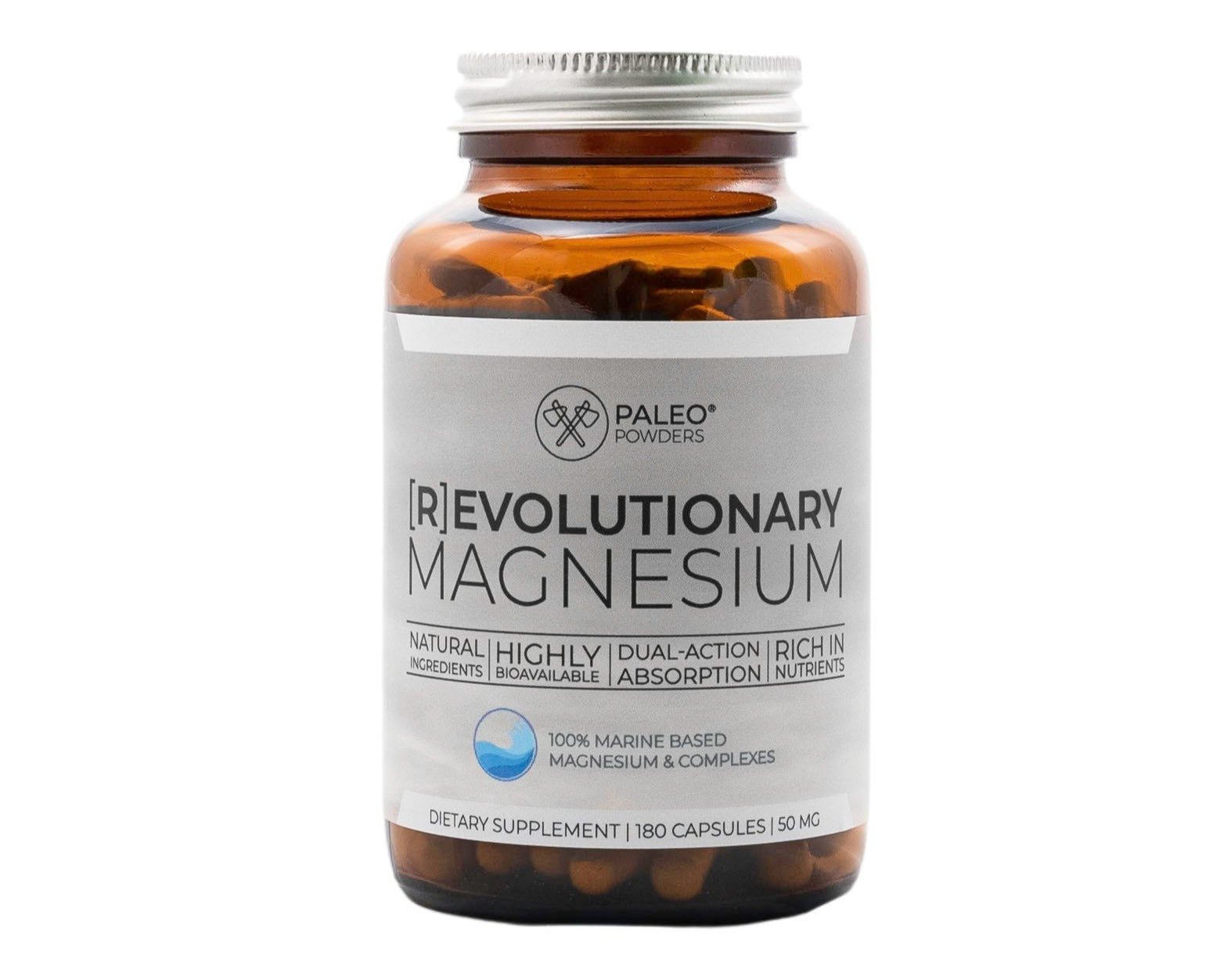
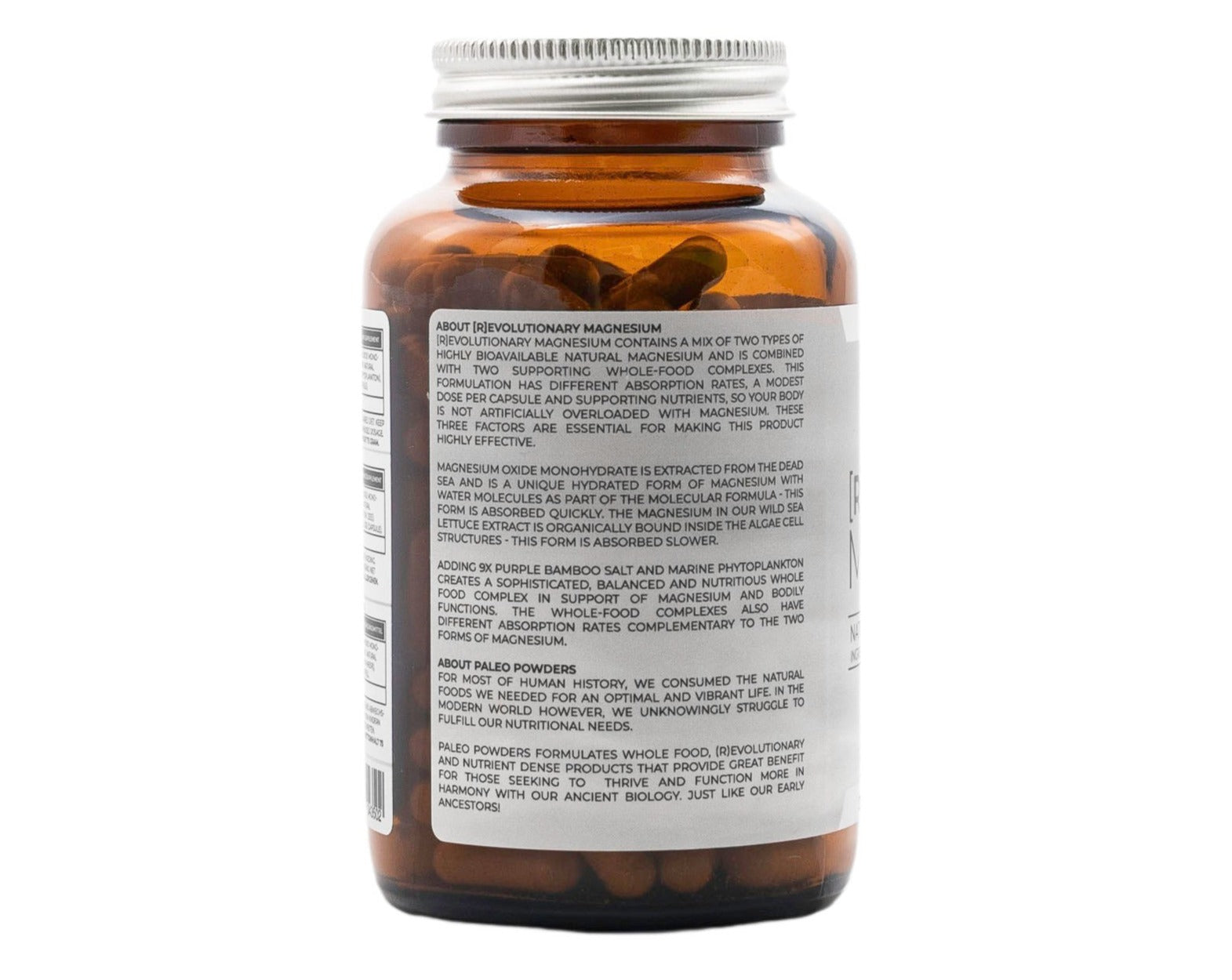
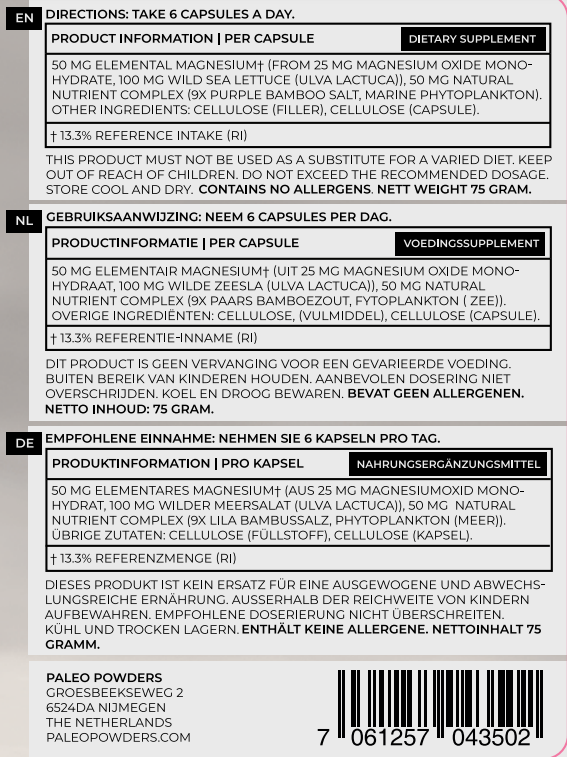
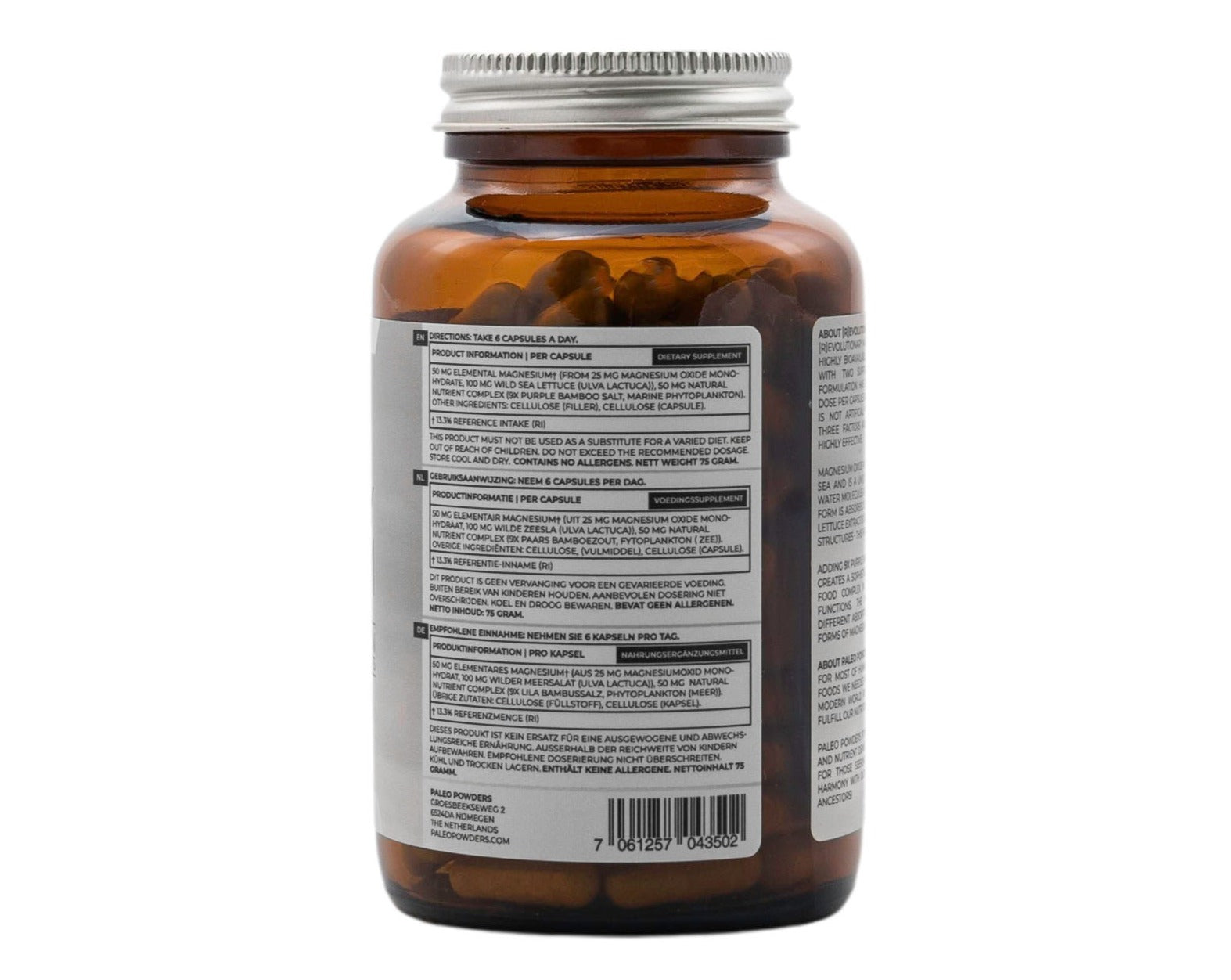
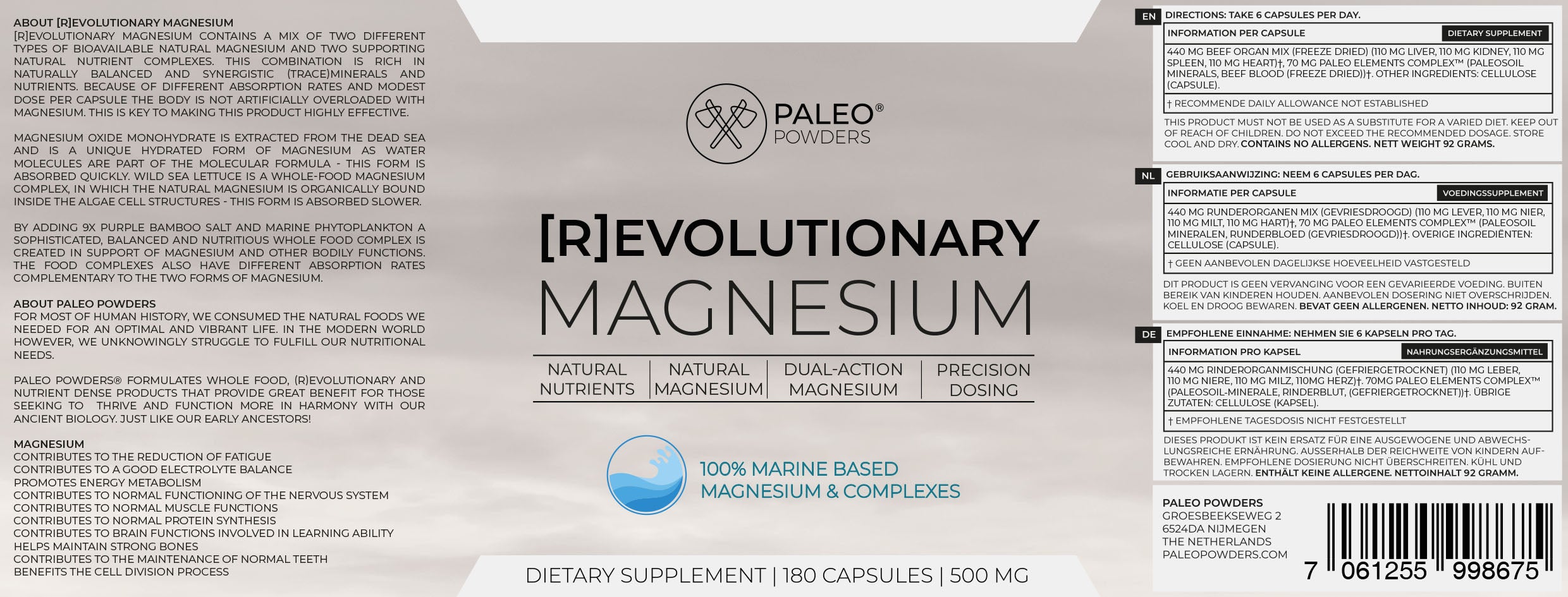
Magnesium - 100% Natural - 180 capsules
Tax included.
Magnesium Oxide Monohydrate is a powerful, pure and natural form of magnesium extracted from the Dead Sea. Compared to most commonly available magnesium forms, this form of magnesium has a particularly good absorption. For example, it is 2.7 times better absorbed by the cells than magnesium citrate.
The effective absorption of Magnesium Oxide Monohydrate
Although regular magnesium oxide is not always positively known, Magnesium Oxide Monohydrate is in a completely different category. This special form of magnesium oxide contains a water molecule as part of its molecular structure. This is crucial for the effectiveness of magnesium, as magnesium is a hydrophilic element. This means that it can only work if there is sufficient water in the environment. By adding an H2O (water) molecule, this critical factor is guaranteed and optimized at molecular level, significantly increasing the bioavailability of Magnesium Oxide Monohydrate.
Unique properties
It is clear that most magnesium supplements are not really unique in composition and ingredients. At Paleo Powders we approach this differently. We combine two natural and complementary forms of magnesium with two natural multinutrient complexes that contain supporting nutritional factors. In this way we offer a unique and highly effective magnesium supplement.
So if you're looking for a good, natural magnesium supplement that stands out from the standard products, look no further. The magnesium capsules from Paleo Powders contain high-quality ingredients and a well-thought-out composition that contribute to optimal absorption and use of this important mineral. Order now and experience the benefits of this unique and powerful magnesium formula for yourself!
Benefits of natural magnesium from Paleo Powders
- Contains Magnesium Oxide Monohydrate, a natural form of magnesium extracted from the Dead Sea, for rapid absorption by the body
- Contains natural Magnesium from Wild Sea Lettuce (Ulva lactuca), a bio-available form of magnesium that is slowly absorbed by the body for long-lasting support
- Combines two bio-available and natural forms of Magnesium for optimal functioning in the body
- Contains a phytoplankton complex and traditional Korean bamboo salt (9x purple bamboo salt), which provide supporting nutrients for maximum absorption and effectiveness
- Formulated in precision dosing capsules, so you always get the right dose
- Purely formulated without fillers, fragrances or flavors and GMO-free for a 100% natural origin
- Contains 50mg of easily absorbable magnesium per capsule
The role of magnesium in human biochemistry and health
Magnesium is an essential mineral with a crucial role in human biochemistry and general health. For example, magnesium is responsible for the activity of thousands of enzymes. This affects about 80% of the metabolism! Nevertheless, magnesium is perhaps the least understood and appreciated mineral. Today's life, the type of diet and food processing are examples of factors that play a role if you want to consider magnesium as a nutritional supplement. [R]evolutionary magnesium from Paleo Powders delivers natural magnesium with an evolutionary approach in a revolutionary nutrient-rich formulation.
To get the most out of a magnesium supplement, it is important that the maker has good knowledge. For example, there are many misconceptions about magnesium that arise from ignoring important factors. For example, the type of magnesium used, absorption profiles and the balance with other minerals. That is why we also think that the standard approach of 100 to 400 mg magnesium chelate in a capsule, tablet or dosage is not the best. An optimal product requires deeper knowledge that goes beyond the current standard. Ultimately, nature knows best!
Daily magnesium intake and food sources
- A good guideline for daily magnesium intake for adults is between 320 mg and 420 mg per day (13–17 mmol/day). An intake of 3.6 mg magnesium per kilo of body weight per day is required to maintain the magnesium balance under normal physiological conditions.
- Foods high in magnesium do not contain a particularly high percentage of the recommended daily allowance. Examples include leafy vegetables (78 mg/serving), nuts (80 mg/serving), chicken (41 mg/serving) and Atlantic Mackerel (82 mg/serving).
- In addition, many fruits and vegetables have lost large amounts of minerals and nutrients over the past 100 years.
- Cooking vegetables can also cause an additional loss of up to 80% in magnesium content. Magnesium in drinking water contributes to approximately 10% of daily intake.
- However, the increased use of softened/purified tap water has seriously affected water as a source of magnesium.
Once magnesium is absorbed, it is distributed throughout the body for use and storage. Once in the blood, magnesium finds its way to muscle tissue (27%) and bone (53%) as well as a variety of other tissues (19%). As much as 99% of the magnesium is located intracellularly in the cells and only 1% in the extracellular space. So almost every cell uses magnesium.
Blood and tissue magnesium are in a constant state of exchange. Kidneys can filter up to 2400 mg of magnesium per day and excrete between 5% and 70% of that magnesium, depending on several variables such as stress, performance and general health.
Only 0.8% magnesium is found in the blood, 0.3% in serum and 0.5% in erythrocytes. Up to a third of the magnesium stored in the boats is interchangeable with magnesium in the blood. Although the total amount of magnesium stored in bone may change with age, bone remains the major area of stored and exchangeable magnesium.
Did you know?
- Magnesium plays a central role in activating more than 3,751 proteins that influence thousands of enzyme systems. This exceeds the often quoted number of "300" in online sources.
- Treating drinking water and processing food reduce naturally occurring magnesium from our diets. Meanwhile, the modern lifestyle ensures that our body uses the magnesium we have in us faster.
- Magnesium is the fourth most abundant mineral in the body, after calcium, potassium and sodium.
- Magnesium cations are the second most abundant mineral in the cell. It can regulate several other cations, including sodium, potassium and calcium.
- Mitochondria concentrate magnesium ions.
- Magnesium appears to be a central regulator of mitochondrial function and metabolism.
- Magnesium also plays a role in making new proteins from amino acids and making and repairing DNA and RNA.
- With a concentration of 0.13 percent, magnesium is the third most abundant mineral in seawater, the human body contains approximately 4-6 teaspoons of magnesium.
Magnesium Oxide Monohydrate: A hydrated form of magnesium
As mentioned earlier, Magnesium Oxide Monohydrate is a natural form of magnesium extracted from the Dead Sea. Because it contains a water molecule, a hydrated form of magnesium is created. This form of magnesium has particularly good absorption compared to most commonly available magnesium forms. For example, it is 2.7 times better absorbed by the cells than magnesium citrate.
Superior Absorption of Magnesium Monohydrate
Regular magnesium oxide does not have a very good reputation, but this monohydrate form is not the same because it contains an extra water molecule! Magnesium is a hydrophilic element. This means that it can only work if there is sufficient water in the environment. By adding an H2O (water) molecule, this critical factor is guaranteed and optimized at molecular level! Due to the high dissolution rate and superior absorption into the body, the bioavailability is very high.
Whole-Food Magnesium: Wild Sea Lettuce Source
Wild sea lettuce (Ulva lactuca) magnesium is a natural source of magnesium but differs from Magnesium Oxide Monohydrate. This whole-food magnesium complex, with the natural magnesium organically bound in the algae cell structures, not only supplies a high natural concentration of magnesium, but also the entire essence of the plant with supporting substances.
Essence of Sea Lettuce: Natural Food
The wild sea lettuce is harvested organically and sustainably off the French and Argentinian coasts. The essence of this sea algae is completely preserved because the processing is done in a mild and sophisticated way. This of course so that it can nourish your body in the best possible way.
By providing natural magnesium in an evolutionary whole-food form, the body is not overwhelmed by a high dose of magnesium. The body processes magnesium from food sources differently. This makes it a superior choice, in our (r)evolutionary perspective.
Difference in recording
Magnesium oxide monohydrate and wild sea lettuce magnesium are two highly bioavailable forms of magnesium, but have different absorption rates. Magnesium oxide monohydrate is absorbed very quickly, while magnesium from wild sea lettuce has a slower absorption rate. This is because the magnesium must first be released from the plant structures.
It is important to know that magnesium, unlike other minerals, can be absorbed along the entire length of the gastrointestinal tract. Taking advantage of this physiological benefit with a two-step approach optimizes magnesium absorption because not all magnesium is absorbed at the same rate.
The role of marine phytoplankton as a food source
Marine phytoplankton has shaped life on Earth throughout its extensive evolutionary history. It is estimated that phytoplankton accounts for more than 45% of the Earth's net primary photosynthetic production. Phytoplankton therefore form the basis of ocean food ecosystems and have an enormous impact on the entire global biosystem.
Phytoplankton are not ocean plants but single-celled aquatic organisms that occur in both saltwater and freshwater environments. The history of plankton goes back more than 3 billion years and is the basis for all life on Earth. How paleo do you want it! These microorganisms are responsible for creating the Earth's atmosphere and allowing the first life forms to flourish.
Phytoplankton is an incredible matrix of nutrients that not only contains a broad spectrum of (trace) minerals, but also phospholipids Omega 3s, all essential amino acids, vitamins, antioxidants, special fatty acids, phospholipids and more.
The 100% Dutch-produced marine phytoplankton (Nannochloropsis gaditana) that we use is produced in a pristine location on the banks of the largest protected nature reserve in the Netherlands. The phytoplankton is grown in ancient seawater (130,000 years old) deep below the surface that is free of contaminants and heavy metals.
The use of Korean bamboo salt
The Korean bamboo salt we use is produced entirely by hand in a traditional way, no mass production techniques are involved. It takes more than 3 years to make purple bamboo sweet. This is done every time according to a precise and special protocol. The sea salt is dried in the sun, placed in bamboo that is at least 3 years old and covered with mineral-rich clay. The bamboo “pots” are then placed in a pine wood oven where the salt melts at 2500°C into a lava. All these steps are repeated 9 times. The salt "lava" that forms at the high temperatures creates smaller molecules, which are more easily absorbed by the body. The process also removes unwanted elements. Together with the high temperatures, activated carbon and sulfur from the bamboo cause the salt to turn purple.
Bamboo salt is one of the most famous traditional medical treatments in Korea and other Asian countries. Bamboo salt contains more than 70 essential minerals, trace elements and micronutrients.
Small Molecules for Big Benefits
Bamboo salt is concentrated and has a very small molecular size of only 1/100th of regular salt molecules (300-600 angstroms). This allows it to move freely between cell membranes. A normal salt molecule is quite large and therefore remains in the bloodstream and draws water from the cells. However, bamboo salt is easily absorbed and excreted due to its small molecular size.
Powerful Alchemy of Bamboo Salt
The unique alchemy that occurs during melting also changes the structures of the molecules into high-energy structures. This makes it more active in physical reactions and therefore even more powerful. The energy of bamboo, pine, clean red clay and fire permeates the salt, maximizing trace element absorption and increasing redox potential.
Bamboo salt has a higher reduction potential because it contains more OH groups than other salts. The reduction peak of bamboo salt is about three times broader than that of solar sea salt in terms of redox potential amperometry (number of ions). Bamboo salt has alkaline properties, more OH groups and higher antioxidant activity. So, a little goes a long way!
Optimal Mineral Balance
Bamboo salt is a unique natural multimineral complex due to its broad spectrum macromineral and micromineral content. 9 X Purple Bamboo Salt is a completely different product than regular sea salt. Not only because of the small molecular size and high energy structure, but also because the content of (trace) minerals has changed. For example, increased zinc, potassium and manganese concentrations.
The body is a system of systems and nothing in the body works in isolation. That is why we believe that taking high doses of magnesium alone is illogical and potentially unwise. Our macrominerals and trace elements must be in balance. When taking nutritional supplements, it is important to maintain this balance in the body. Nature by definition provides this balance. For this reason, marine phytoplankton and 9X purple bamboo salt are valuable additions to our two natural forms of magnesium.
Ionology and Minerals
The importance of mineral balance has been known for some time but is reaffirmed by the new multidisciplinary science of ionology. This is the study of the complete set of mineral nutrients and trace elements in an organism. It uses advanced techniques to investigate the composition and distribution of all minerals and trace elements in a living organism and their variations under various physiological and pathological conditions. The molecular mechanisms underlying the metabolism, homeostasis and interaction of these elements are also studied. The set of all mineral nutrients and trace elements found in an organism is called the ionome.
Unique Multimineral Complex
We have applied this knowledge in our formulation with hundreds of additional nutrients from natural sources, including many special, and of course, a broad spectrum of magnesium-supporting and balancing (trace) minerals. As with the dual-step absorption of magnesium, we have also applied this property to the nutrient complexes in which 9X bamboo salt is absorbed more quickly, and the marine phytoplankton more slowly because the nutrients must first be released from the phytoplankton cells.
Bamboo Salt and Marine Phytoplankton Synergy
By combining two different natural forms of magnesium with complementary absorption rates and adding a fascinating blend of nutrients, we have formulated a super magnesium product. It is suitable for people who are looking for a higher therapeutic dose, but also for people who want to supplement their daily diet with that little bit extra.
Low dosage of magnesium per capsule
Because minerals are better absorbed in smaller doses taken throughout the day, and so as not to overwhelm body systems or molecular pathways that use magnesium (think mitochondria), we don't use the high magnesium amounts per capsule commonly used elsewhere.
We have opted for a lower dose of 50 mg elemental magnesium per capsule. This way it is easier to spread magnesium throughout the day and you get the most out of this product. If dosing during the day is impractical or impossible, you can simply take two or three capsules at a time. Lower doses and the smaller capsule size also make this product better suited for people of smaller stature and children.
Content
Instructions
INGREDIENTS
Choose options









